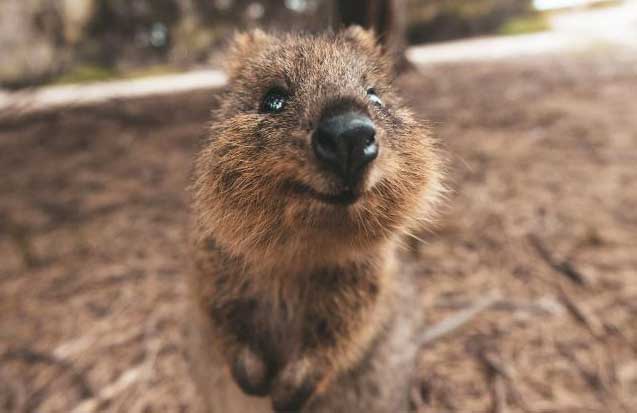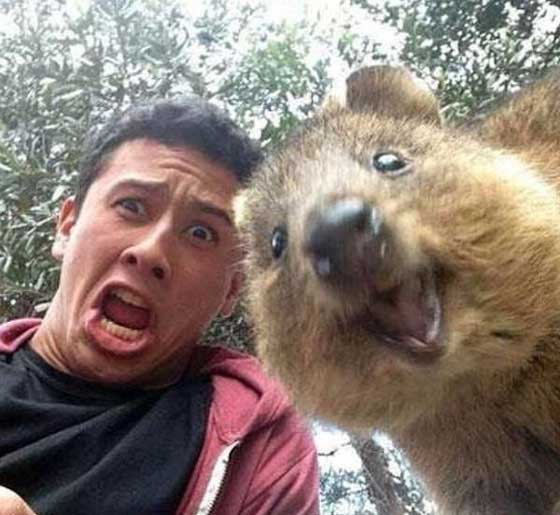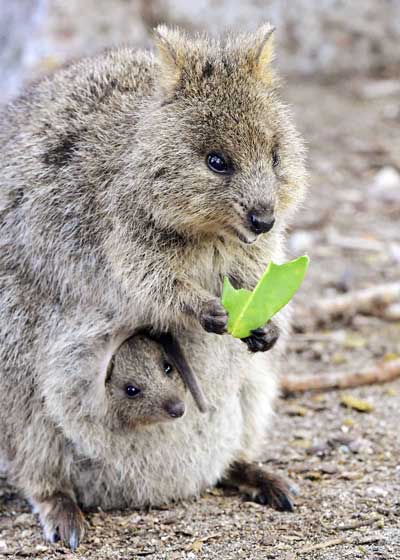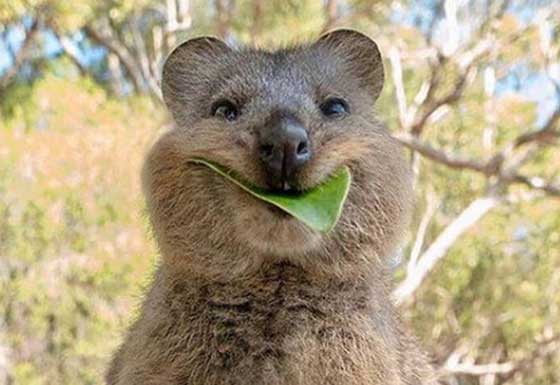|
Perhaps you have recently seen photos of a ridiculously cute-looking animal on social media—an animal that always seems to be smiling. If so, it is probably a Quokka. This creature, which is a small species of wallaby-like marsupial, has gone from being relatively unknown to becoming a selfie superstar. I recently saw a few photos, and I simply had to feature it as an Awesome Animal. What the heck is a Quokka? The quokka (pronounced kwok-uh) is a macropod (the family that includes kangaroos, wallabies, wallaroos, tree kangaroos, and more). They are about the size of a domestic cat, and they live in far western Australia, including several islands, especially Rottnest Island. For whatever reason, quokkas seem to have almost no fear of humans. Because of their goofy "smiles," National Geographic has deemed quokkas to be the "world's happiest animal." Amazing facts about Quokkas The first person to describe quokkas was a Dutchman named Volkersen. He found many of them on an island off the west coast of Australia. In 1696 he described the creature as "a kind of rat as big as a common cat." Well, obviously they are not rats, but that did not stop Volkersen from naming the island Rotte Nest (which means rat's nest). Eventually, the island was permanently named Rottnest. The name quokka was given to the animal by the Aboriginal people of that area. Okay, we need to talk about this creature's face, which makes the quokka a contender for the cutest animal ever. As I'm sure you're aware, quokkas are not really smiling. This is simply the shape of the creature's mouth. And those prominent front teeth often contribute to the illusion of a smile. In 2015, someone visited Rottnest Island, took a selfie alongside a quokka, and posted it to social media. The image went viral, and before long, Quokka Selfies became a big deal. A REALLY big deal. If you do a Google Image search for "quokka selfies," you will find literally thousands of them. People travel to Rottnest Island just to take quokka selfies. Apparently, these photos are not difficult to take because the creatures don't mind having a big human sprawl in the grass beside them with a camera. It is illegal to touch quokkas, but that doesn't stop people from cozying up to them for photos. Quokkas are vegetarians. They primarily eat grasses, sedges, and leaves, but their favorite food is a small shrub native to Western Australia called Guichenotia ledifolia, a type of mallow. Humans are warned to not feed quokkas, and especially not human food, which can cause malnourishment and dehydration in quokkas. Rottnest Island in particular, and Australia in general, take this stuff seriously (as they should). On Rottnest Island, you will be fined $300 if you're caught feeding a quokka. You definitely don't want to get caught being cruel to them (or other animals in Australia). The maximum penalty for animal cruelty is a $50,000 fine and five years in prison. Here's another good reason not to touch quokkas... the quokkas on Rottnest Island bite dozens of people per year. Maybe they are getting tired of selfies. I feel the need to dispel a popular myth, that mother quokkas throw their babies at predators to escape being eaten. This idea started as a joke on social media, and since then it has become widely reported as fact. It is NOT true. However, there are some interesting facts that may have contributed to this. Quokkas are marsupials, so the mothers keep their babies in a pouch. When running away from a predator, sometimes these babies (unfortunately) fall out of the pouch. The mother keeps running, leaving the baby behind. This can also happen with other marsupials. Here's the strange part. Studies have shown that, in quokkas, the mothers may drop the babies on purpose. When their lives are in danger from a pursuing predator, they can release their pouch muscles, causing the baby to fall out. The baby then distracts the predator, allowing the mother to escape. It's kind of like when a lizard loses its tail. The tail wriggles around, distracting the predator, allowing the lizard to escape. Yeah, I suppose you're thinking quokkas will never get the mother-of-the-year award, but consider this. If the predator catches the mother, it will kill both the mother and the baby. If the mother escapes, she is already proven to be reproductively fertile and will likely have more babies. Yeah, the mathematics of this makes sense, but I'm sure many people still find it strange. Let's talk about these babies a bit more (I don't want you to be mad at quokkas for dropping their babies). Quokkas give birth to one baby only 27 days after mating. Remember, these creatures are marsupials, so the babies are born very small, the size of a jelly bean. The tiny joey climbs from the birth canal to the pouch using its "hands." Then it stays in the pouch for about six months. Now, this is really cool... the mother will have several other babies in her womb in a suspended state of development, ready to develop if something bad happens to the baby that was already born. These embryos are back-ups, just in case. By the way. The fact that the mothers eject their babies when frightened is a really good reason why people should not harass these creatures! Here's an odd tidbit of information. The relatively large population of quokkas on Rottnest Island have criminals to thank for their abundance. Why? In the late 1830s the island was designated as an Aboriginal penal colony. This kept most people away from the island, which meant that the habitat there remained undisturbed for a long time. So, Quokkas deserve a place in the B.C.A.H.O.F. (Blue-Chip Animal Hall of Fame). FUN FACT: The phrase blue-chip was first recorded in 1923. The term was used by a guy named Oliver Gingold, an employee at Dow Jones. He was describing certain stocks trading at $200 or more per share. He got this from poker, in which the blue chips were worth more than the red and white chips. Eventually, blue chip no longer meant stocks with a high price tag, but instead it referred to stocks of high-quality companies. And, as often happens, people started using the term in a broader sense, to describe people that had excellent qualities, such as a blue-chip athlete, or a blue-chip scientist. So, blue-chip is another way to say awesome! Photo Credits:
Quokka #1 - Tourism Australia Quokka showing teeth - Suzana Paravac/@CruzySuzy/Instagram Quokka selfie - Twitter Quokka with baby - EverywhereWild Quokka eating leaf - All That's Interesting
0 Comments
Leave a Reply. |
Stan's Cogitations
Everyone needs a creative outlet. That's why I write. Archives
July 2024
|






 RSS Feed
RSS Feed